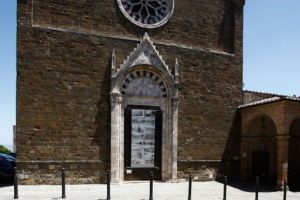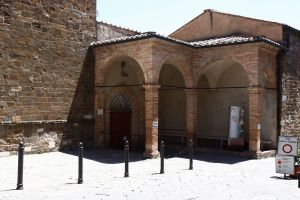The Co-cathedral of the SS. Salvatore in Montalcino
Church of S. Agostino
Continuing just a short distance we come on the left to the church of Sant’Agostino, which from the fourteenth century served one of the most important mendicant orders.
The building was part of the convent complex of the Augustinians. Its interior is a large hall, in keeping with the typical form of the churches of the mendicant orders, designed to hold the greatest possible number of faithful. Built in the early fourteenth century, its interior still exudes a contemplative, solemn atmosphere. It is decorated with fifteenth-century frescoes attributed in part to Bartolo di Fredi.
The convent next to the church housed the Augustinian friars. Their common life took place in the splendid sixteenth-century cloisters and the refectory. When the order was suppressed as a result of the reforms enacted by Grand Duke Leopold in 1786, the building became the home of the seminary, which also served the young people of Montalcino as their high school. Currently the space houses the Civic and Diocesan Museum of Sacred Art.
The building was part of the convent complex of the Augustinians. Its interior is a large hall, in keeping with the typical form of the churches of the mendicant orders, designed to hold the greatest possible number of faithful. Built in the early fourteenth century, its interior still exudes a contemplative, solemn atmosphere. It is decorated with fifteenth-century frescoes attributed in part to Bartolo di Fredi.
The convent next to the church housed the Augustinian friars. Their common life took place in the splendid sixteenth-century cloisters and the refectory. When the order was suppressed as a result of the reforms enacted by Grand Duke Leopold in 1786, the building became the home of the seminary, which also served the young people of Montalcino as their high school. Currently the space houses the Civic and Diocesan Museum of Sacred Art.




